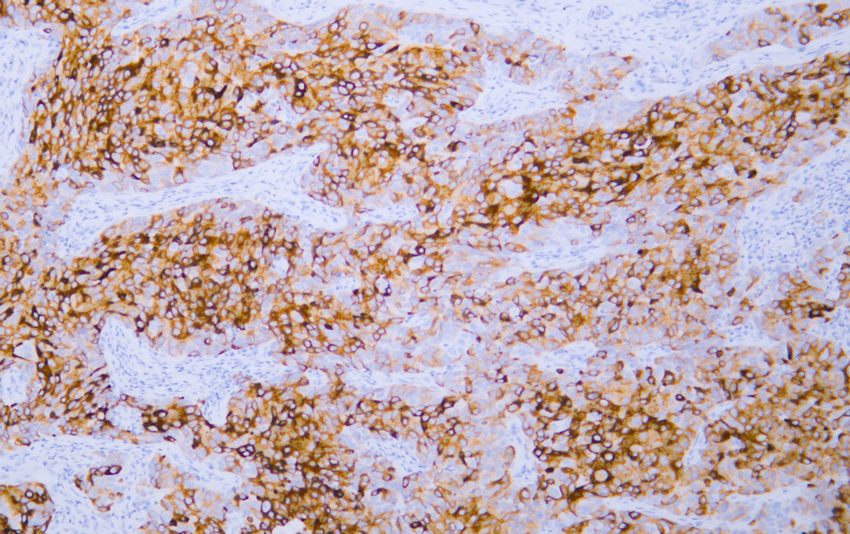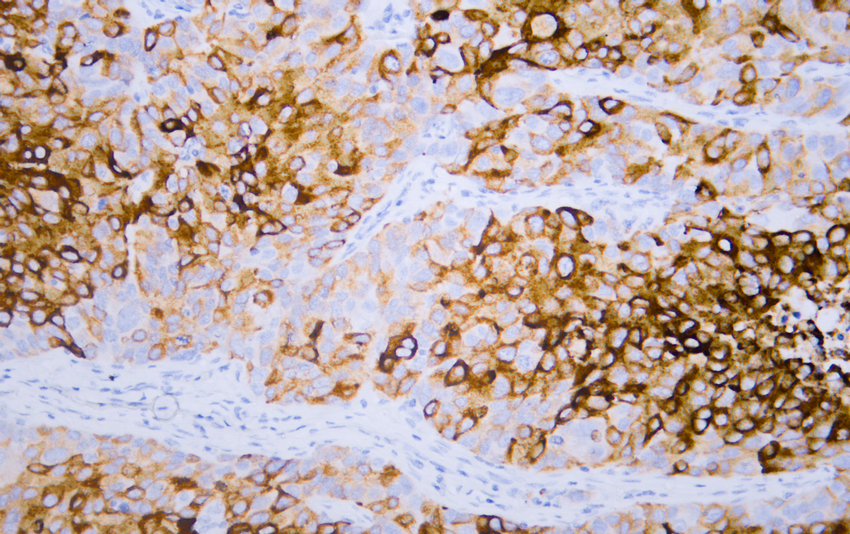pS2 (ABT265) IHC kit
- Catalog No.:IHCM6907
- Applications:IHC
- Reactivity:Human;
- Target:
- pS2
- Fields:
- >>Estrogen signaling pathway
- Gene Name:
- TFF1 BCEI PS2
- Protein Name:
- pS2
- Human Gene Id:
- 7031
- Human Swiss Prot No:
- P04155
- Immunogen:
- Synthesized peptide derived from human pS2 AA range: 25-84
- Specificity:
- The antibody can specifically recognize human pS2 protein.
- Source:
- Mouse, Monoclonal/IgG1, kappa
- Purification:
- The antibody was affinity-purified from ascites by affinity-chromatography using specific immunogen.
- Storage Stability:
- 2°C to 8°C/1 year
- Other Name:
- Trefoil factor 1 (Breast cancer estrogen-inducible protein;PNR-2;Polypeptide P1.A;hP1.A;Protein pS2)
- Background:
- Members of the trefoil family are characterized by having at least one copy of the trefoil motif, a 40-amino acid domain that contains three conserved disulfides. They are stable secretory proteins expressed in gastrointestinal mucosa. Their functions are not defined, but they may protect the mucosa from insults, stabilize the mucus layer, and affect healing of the epithelium. This gene, which is expressed in the gastric mucosa, has also been studied because of its expression in human tumors. This gene and two other related trefoil family member genes are found in a cluster on chromosome 21. [provided by RefSeq, Jul 2008],
- Function:
- disease:Expressed in a number of carcinomas including breast (50%), pancreas (70-75%), stomach (50-55%), and large bowel (58%).,function:Stabilizer of the mucous gel overlying the gastrointestinal mucosa that provides a physical barrier against various noxious agents. May inhibit the growth of calcium oxalate crystals in urine.,similarity:Contains 1 P-type (trefoil) domain.,subunit:Heterodimer with GKN2; disulfide linked.,tissue specificity:Found in stomach, with highest levels in the upper gastric mucosal cells (at protein level). Detected in goblet cells of the small and large intestine and rectum, small submucosal glands in the esophagus, mucous acini of the sublingual gland, submucosal glands of the trachea, and epithelial cells lining the exocrine pancreatic ducts but not in the remainder of the pancreas (at protein level). Scattered expression is detected in the epithelial cells of
- Subcellular Location:
- Cytoplasmic
- Expression:
- Found in stomach, with highest levels in the upper gastric mucosal cells (at protein level). Detected in goblet cells of the small and large intestine and rectum, small submucosal glands in the esophagus, mucous acini of the sublingual gland, submucosal glands of the trachea, and epithelial cells lining the exocrine pancreatic ducts but not in the remainder of the pancreas (at protein level). Scattered expression is detected in the epithelial cells of the gallbladder and submucosal glands of the vagina, and weak expression is observed in the bronchial goblet cells of the pseudostratified epithelia in the respiratory system (at protein level). Detected in urine (at protein level). Strongly expressed in breast cancer but at low levels in normal mammary tissue. It is regulated by estrogen in
- June 19-2018
- WESTERN IMMUNOBLOTTING PROTOCOL
- June 19-2018
- IMMUNOHISTOCHEMISTRY-PARAFFIN PROTOCOL
- June 19-2018
- IMMUNOFLUORESCENCE PROTOCOL
- September 08-2020
- FLOW-CYTOMEYRT-PROTOCOL
- May 20-2022
- Cell-Based ELISA│解您多样本WB检测之困扰
- July 13-2018
- CELL-BASED-ELISA-PROTOCOL-FOR-ACETYL-PROTEIN
- July 13-2018
- CELL-BASED-ELISA-PROTOCOL-FOR-PHOSPHO-PROTEIN
- July 13-2018
- Antibody-FAQs
- Products Images

- Human breast carcinoma tissue was stained with Anti-pS2 (ABT265) Antibody

- Human breast carcinoma tissue was stained with Anti-pS2 (ABT265) Antibody



